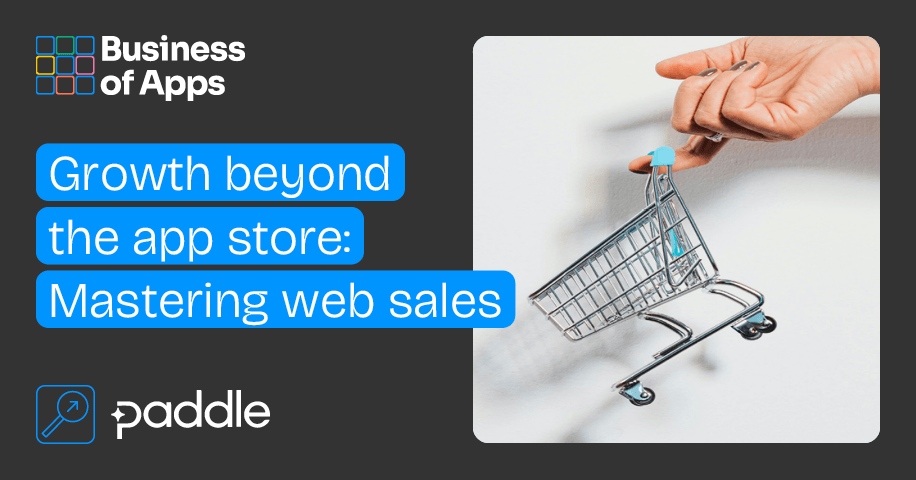Apple and Google dominate mobile app sales, controlling over 95% of the App Store market outside of China. These platforms are home to millions of apps and billions of dollars worth of sales — $87B in 2022 alone — making them invaluable for app developers looking to grow, and, for many, app stores are their primary revenue source.
However, Epic Games’ long-running legal battles with Apple and Google have highlighted the issues developers face with app stores. While app stores provide a one-stop shop for launching and distributing an app worldwide, they also come with strict rules and platform fees.
So how can developers grow sales that are not subject to these restrictions, boost revenue, and de-risk their reliance on app stores?
The problems with app stores
App store operators can charge developers a 30% commission on sales, seriously eating into profit margins (especially for smaller developers). Apple makes an estimated $15B annually from these fees alone. Even as the EU’s Digital Markets Act has forced these commissions to come down to 12-17%, this comes with a “core technology fee” of €0.50 for every download over 1 million.
At the same time, acquisition costs are increasing on app stores. Apple’s SKAdNetwork (SKAN) reduced developers’ visibility into ad performance and tracking, forcing them to spend more to acquire users.
With over 250B new app downloads and $170B of app spend last year, app developers are rightly now seeking out opportunities to maximize their revenue beyond app stores.
Web monetization – the opportunities…
Mastering web monetization — selling an app through the web as well as through app stores — offers developers the opportunity to scale faster, boost revenue, and learn much more about their customers.
The most attractive impact of web monetization is that it can dramatically increase the lifetime value of apps by avoiding the fees imposed by app stores and reducing your customer acquisition costs.
Web sales can significantly broaden the number of customers developers can reach. The potential customer base on the web is largely untapped, with only a 15% overlap between total web users and app store users. This approach also offers greater customer acquisition flexibility, with no need to adhere to SKAN.
Selling on the web also gives developers control over how they bill their customers, helping reduce overall subscription churn. In the App Store, 23% of all involuntary churn was due to billing errors between the customer and Apple. Web sales let developers offer flexibility to customers in how they pay, supporting retention and growth.
…and challenges
Web monetization is something that all developers should consider, but it is not as simple as setting up an online shop. There are several technical challenges that developers will need the expertise to build or look to outsource.
Companies should evaluate whether they have the resources, revenue, or capital to dedicate before taking this leap.
In return for high fees, app stores handle some payment complexities on behalf of developers, allowing them to sell internationally and accept multiple payment methods.
Web monetization requires building a payments infrastructure that can replicate this minus the commission, while also handling sales tax liabilities and local pricing strategies to make the most out of international sales.
Developers also need to consider customer expectations. Users are familiar with app stores, and implicitly trust them more than web payments, with only 1.5-2% of users completing a purchase when they reach a paywall online.
To overcome these challenges, developers need to think carefully about their web monetization strategy.
Choosing the right web monetization strategy
The right web monetization strategy will vary from app to app. There are three core strategies that developers should know: web-to-app, web store, and hybrid.
A web-to-app strategy – where a user is acquired online, purchases a subscription on the web and is then directed to download and use the app – works well for lifestyle and content-based apps, like language-learning, fitness, and personal development apps.
Web-to-app acquisition funnel
Source: Paddle
It requires building a web-to-app funnel, where a user is taken from a targeted ad to a web-based paywall – bypassing app store fees in the process. The customer is then directed to sign in and use the app as normal.
Paywall design is critical for a successful web-to-app funnel. While customers are familiar with app store UI, web paywalls need to be designed to build trust and drive conversion. Consider making them longer to show a user what they get for paying and including some FAQs, reviews and ratings, and a guide to global and alternative payment methods (like buy now, pay later).
A web store strategy, where customers are directed to make purchases in a separate web store, is another popular option.
This is used by game developers who cultivate a loyal fanbase that they can direct to make a web payment for in-game extras and items.
Web stores invite customers to make a payment through a 3rd-party processor on the web, with their purchase connected to their account and available when they return to the app.
A hybrid strategy is ideal for products that can be used on both mobile and desktop, such as Spotify.
This strategy sees developers acquire new customers on the web (through targeted marketing campaigns) and through a standard app acquisition flow – with both customer segments encouraged to transact through web checkout. Customers can then log in and use the app on their mobile and the web.
How to choose the right web monetization strategy for your app
Source: Paddle
Managing payments
Implementing a payments infrastructure is a major technical challenge for web monetization, but one of the most important. Without properly planning this, developers pursuing web monetization face serious problems – from lost revenue to missed tax obligations.
Developers can build their own payments infrastructure, though this generally requires a specially skilled team to build and maintain.
Alternatively, they could use a merchant of record (MoR), which manages payments, subscriptions, tax compliance, and financial obligations on behalf of app developers. The App Store and Google Play Store act as MoRs meaning most developers are familiar with the model. Selling on the web with an MoR means you’re offloading the hassle without getting stung by high fees (MoR fees can start from around 5%).
MoRs will also usually afford developers more flexibility around payments – allowing them to sell through multiple currencies and payment methods easily all over the world, and implement offers to attract new customers and reduce churn.
Growing on your own terms
For those ready to take the leap, web monetization can drastically increase revenue, provide brand-new channels for customer acquisition, and enable international sales.
Before taking the leap, developers need to ask if they have the resources to monetize web sales successfully.
App stores are still dominant in the market, and maintaining a strong app store strategy is still key to many developers’ businesses. Web monetization strategies complement this, helping developers diversify their revenue, reduce their reliance on app stores, and start to flourish and grow on their own terms.













